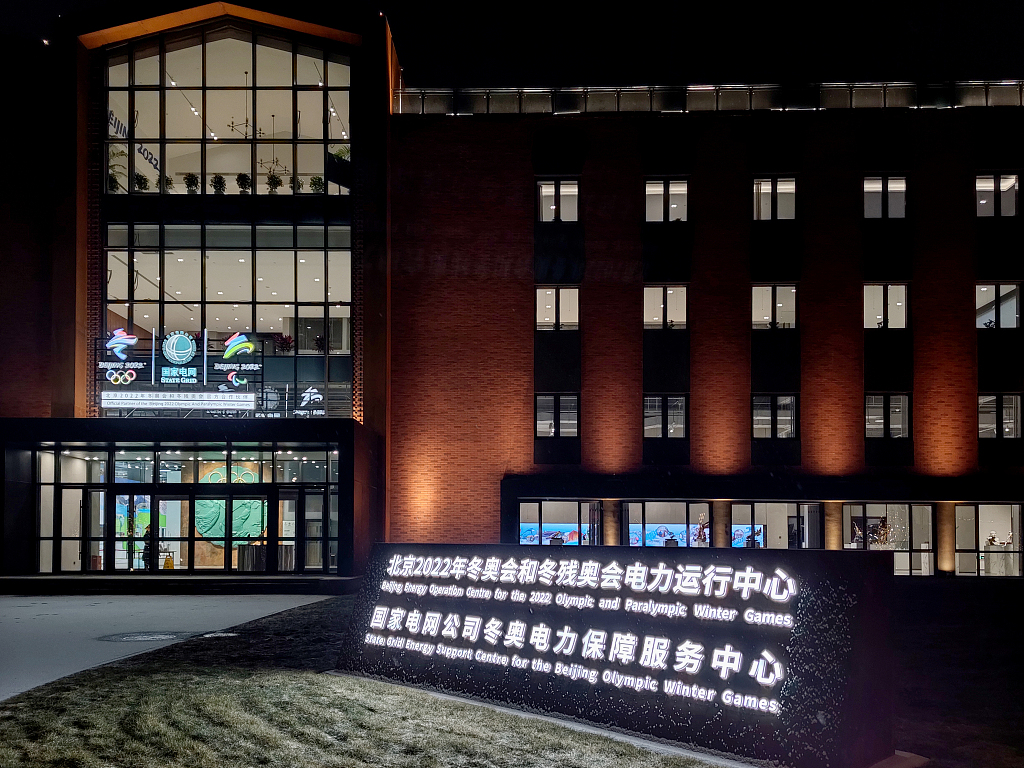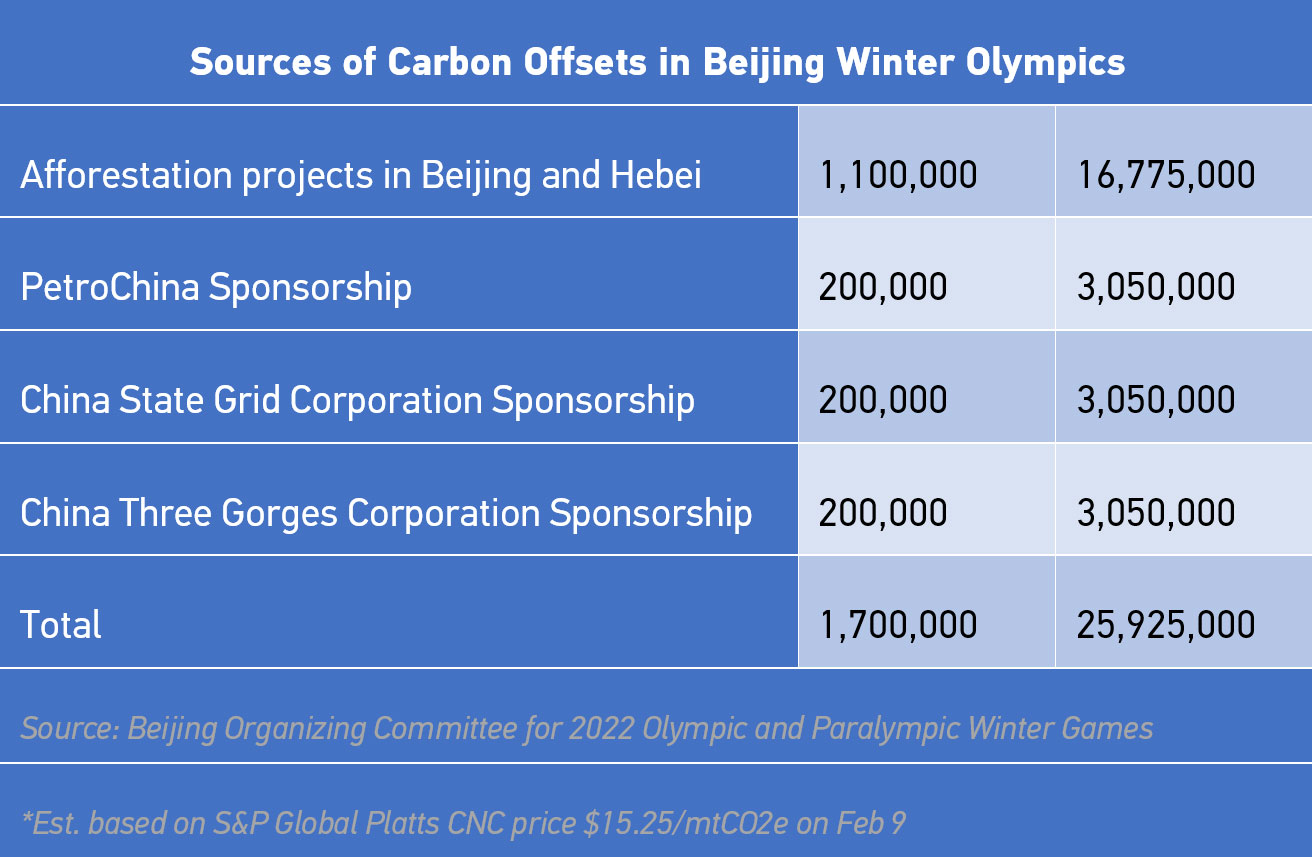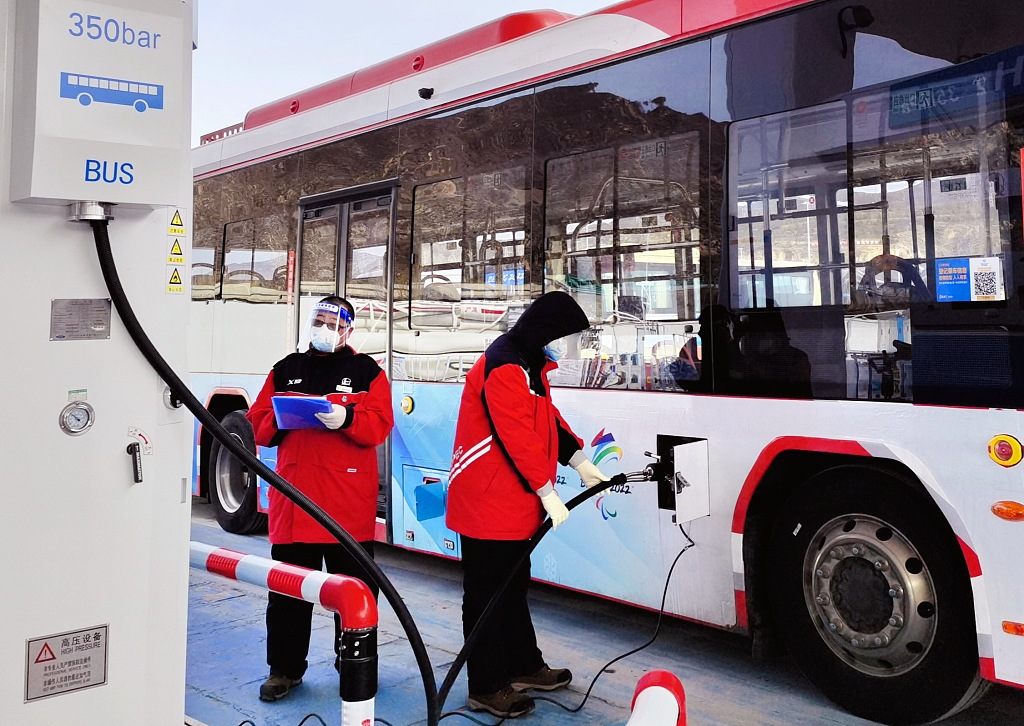
The State Grid Energy Support Center for the Beijing Olympic Winter Games at Shijingshan District, Beijing. /CFP
The State Grid Energy Support Center for the Beijing Olympic Winter Games at Shijingshan District, Beijing. /CFP
Editor's note: Eric Yep is a senior writer for S&P Global Platts ASEAN content, and Ivy Yuwei Yin is an energy transition writer for S&P Global Platts APAC. The views expressed in the article are the authors' personal views and do not stand for that of CGTN.
The Beijing Winter Olympics is "carbon neutral" with hydrogen fueling the Olympic torch and powering over 800 vehicles, 100 percent renewable energy plants to support the event venues, and 1.7 million carbon credits to offset emissions. The use of a fully renewable energy powered grid, with pumped hydro to manage intermittency, helps reduce the CO2 footprint, and the remaining emissions are offset using carbon credits from forestry projects.
While this is not the first sporting event or Olympics to reduce its carbon footprint, it sets the template for how future global events will be conceptualized: focusing first on reducing emissions instead of relying on offsets, which industry experts admit are a last resort. The higher the offsets needed, the fewer efforts done to avoid or reduce real emissions. Such events help us understand where CO2 emissions for global events come from so that reduction efforts can focus on the right areas. For example, the Davos World Economic Forum and the COP26 conference saw a large portion of emissions from travel, including private jets and international flights.
Total baseline emissions of the Winter Olympics were initially estimated back in 2018 to be at 1.637 million metric tons of CO2 equivalent (mtCO2e). This estimate is now down to 1.306 million mtCO2e with more environment-friendly infrastructure built for the games. The organizers had prepared 1.7 million carbon credits, while the actual offsets needed are expected at around 1.028 million mtCO2e, according to its sustainability report.
Actual emissions are lower than expected because COVID-19 restrictions limited the number of spectators. For context, a business class flight from London to Hong Kong amounts to 10 tons of CO2e, according to an estimate by author Mike Berners-Lee in his book "How Bad are Bananas? The Carbon Footprint of Everything." If the carbon credits prepared for the Games are not used elsewhere, the Beijing Games will have surplus offsets. At current market prices, 1.7 million carbon credits would cost around $26 million, based on the S&P Global Platts Nature-Based Carbon Credits price of $15.30 per mtCO2e on February 10.
Zhangjiakou Renewable Energy Zone
Beijing 2022 will be the first Olympic Games to have all venues powered by renewable energy, with solar and wind as primary energy sources, the International Olympic Committee (IOC) said.
The power comes from the Zhangjiakou Renewable Energy Zone in Hebei Province, adjacent to Beijing, which is rich in wind and solar resources. Zhangbei County in Zhangjiakou City will operate 2.6 gigawatts (GW) wind power and 1.9 GW solar power capacity, and Kangbao County will operate 1.35 GW wind power and 0.9 GW solar, according to the Winter Olympics' Pre-Games Sustainability Report.
Zhangjiakou is an emerging renewable energy hub in northern China, which released its energy development plan in 2015, the same year that Beijing won its bid to host the Winter Olympics. It has the potential for 40 GW of wind power capacity and 30 GW of solar and expects to install 50 GW of renewables-based power by 2030 to supply the whole Beijing-Tianjin-Hebei region.
By 2030, the Zhangjiakou Renewable Energy Zone is expected to substitute fossil fuels of 33 million tonne of standard coal equivalent and cut CO2 emissions by 85 million tonne, the development plan said. Also, Zhangjiakou plans 80 percent renewables in its generation mix, and targets to have all public transport and residential energy using renewables, and net-zero emissions in all industrial sectors by 2030, its plan said.
China has also set a nationwide target for increasing the solar and wind installation capacities to 1,200 GW by 2030, a 189 percent increase from the capacity in 2021. Some of China's largest state-owned generation utilities like Huadian Group, Huaneng Group, Datang Group and Guohua Power have developed green power projects in Zhangjiakou.

How green power is transmitted and traded
To transmit electricity from Zhangjiakou to Beijing, a flexible DC power grid has been developed for 14.1 billion kilowatt-hours (kWh) of annual transmission, equivalent to 10 percent of the city's electricity consumption, according to organizers.
A pumped-storage hydropower plant developed by State Grid of China in Fengning, Hebei Province, will help manage intermittency when wind and solar power are not available. Compared with technologies like utility-scale batteries, utilizing hydropower for energy storage is less complex and more cost-effective. The Fengning pumped-storage hydropower plant has total planned installed capacity of 3.6 GW, and two generation units started operating December 30, 2021, with a capacity of 600 megawatts, according to data from National Energy Administration.
China's total pumped-storage capacity is expected to reach 62 GW by 2025, doubling from current levels, and 120 GW by 2030, according to NEA's development plan for pumped hydro released last year. China has also established trading rules and platforms for Olympic venue operators to purchase green electricity directly from generation utilities and power companies.
Beijing Power Exchange Center, partly owned by State Grid, has been organizing the green power trading to support the Beijing Games, according to China's top economic planner National Development and Reform Commission. In 2021, 14 operators of Olympic venues and facilities in Beijing and Zhangjiakou participated in the market-based green power trading with 14 generation utilities, such as Huadian Group and Huaneng Group, NDRC said in a recent statement. Green power trading for Olympic venues in January-April 2022 totaled 141 million kWh. Even after the Games, power trading will underpin renewables expansion in China.

Staff at Sinopec's hydrogen refueling station are fueling vehicles for the Winter Olympics, Zhangjiakou, Hebei Province, China. /CFP
Staff at Sinopec's hydrogen refueling station are fueling vehicles for the Winter Olympics, Zhangjiakou, Hebei Province, China. /CFP
Hydrogen in the spotlight
The Olympic torch is mainly powered by hydrogen supplied by oil major Sinopec. There are 816 hydrogen-fueled vehicles deployed at the Games. China is running its first 400 kW hydrogen-fueled mobile power generator, which serves as a portable charger that can operate at temperatures as low as minus 40 degrees Celsius. National oil companies Sinopec and PetroChina have each established four hydrogen fueling stations near Olympic venues.
PetroChina said its hydrogen fueling stations can provide 5,500 kg/d of hydrogen in total, which can support nearly 1,000 hydrogen-fueled vehicles. Its annual hydrogen production capacity has exceeded 2.6 million tonne per year, including hydrogen produced from fossil fuels, industrial byproducts, and renewables. Sinopec's fueling stations mainly serve hydrogen-fueled vehicles in Yanqing, Beijing, and Zhangjiakou and are capable of providing 2,500 kg/d hydrogen to 212 vehicles in Yanqing and 1,000 kg/d to vehicles in Zhangjiakou. Sinopec's hydrogen production capacity from its refining processes was 3.9 million tonne per year, accounting for 11 percent of China's hydrogen output, Platts reported earlier.
In 2021, Sinopec announced its plans to invest $4.6 billion in hydrogen through 2021-2025 and boost green hydrogen production capacity to 500,000 tonne per year by 2025.
Carbon offsets
The Winter Olympics in Beijing's carbon reduction plan was developed with Tsinghua University, which also designed China's national carbon market, and has been certified by the China Environmental United Certification Center.
The offsets used are China Certified Emission Reductions, China's domestically certified carbon credits, and sourced from different providers, including afforestation projects in Beijing and Zhangjiakou and state-owned enterprises PetroChina, State Grid Corp. and renewable project developer China Three Gorges Corp. Offsetting GHG emissions using nature-based carbon credits has become increasingly popular globally, and big events will help drive demand for offsets, pushing carbon prices up.
A spokesperson at the Beijing 2022 Games said the International Olympics Committee is obliging the sporting event to be "climate positive" from 2030.
"This means that the IOC will require organizers to reduce direct and indirect emissions of the Games, compensate more than the remaining ones, and create lasting zero-carbon solutions for the Games and beyond," the spokesperson said.
But even before the 2030 target, the spokesperson said Paris is already setting up to stage the first climate positive Olympics in 2024. Paris also aims to reduce carbon emissions by 50 percent compared with previous Olympics, partly because 95 percent of its venues will be pre-existing or temporary. The Los Angeles Olympics in 2028 will go a step further, not building a single new venue for the Games.

